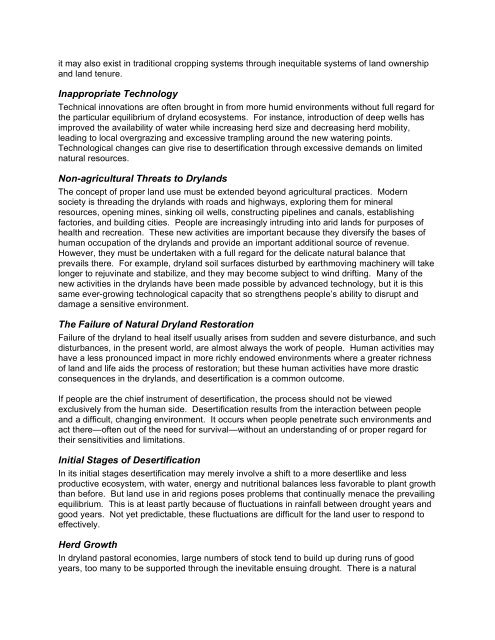Natural Hazards: Causes and Effects - Disaster Management Center ...
Natural Hazards: Causes and Effects - Disaster Management Center ...
Natural Hazards: Causes and Effects - Disaster Management Center ...
Create successful ePaper yourself
Turn your PDF publications into a flip-book with our unique Google optimized e-Paper software.
it may also exist in traditional cropping systems through inequitable systems of l<strong>and</strong> ownership<br />
<strong>and</strong> l<strong>and</strong> tenure.<br />
Inappropriate Technology<br />
Technical innovations are often brought in from more humid environments without full regard for<br />
the particular equilibrium of dryl<strong>and</strong> ecosystems. For instance, introduction of deep wells has<br />
improved the availability of water while increasing herd size <strong>and</strong> decreasing herd mobility,<br />
leading to local overgrazing <strong>and</strong> excessive trampling around the new watering points.<br />
Technological changes can give rise to desertification through excessive dem<strong>and</strong>s on limited<br />
natural resources.<br />
Non-agricultural Threats to Dryl<strong>and</strong>s<br />
The concept of proper l<strong>and</strong> use must be extended beyond agricultural practices. Modern<br />
society is threading the dryl<strong>and</strong>s with roads <strong>and</strong> highways, exploring them for mineral<br />
resources, opening mines, sinking oil wells, constructing pipelines <strong>and</strong> canals, establishing<br />
factories, <strong>and</strong> building cities. People are increasingly intruding into arid l<strong>and</strong>s for purposes of<br />
health <strong>and</strong> recreation. These new activities are important because they diversify the bases of<br />
human occupation of the dryl<strong>and</strong>s <strong>and</strong> provide an important additional source of revenue.<br />
However, they must be undertaken with a full regard for the delicate natural balance that<br />
prevails there. For example, dryl<strong>and</strong> soil surfaces disturbed by earthmoving machinery will take<br />
longer to rejuvinate <strong>and</strong> stabilize, <strong>and</strong> they may become subject to wind drifting. Many of the<br />
new activities in the dryl<strong>and</strong>s have been made possible by advanced technology, but it is this<br />
same ever-growing technological capacity that so strengthens people’s ability to disrupt <strong>and</strong><br />
damage a sensitive environment.<br />
The Failure of <strong>Natural</strong> Dryl<strong>and</strong> Restoration<br />
Failure of the dryl<strong>and</strong> to heal itself usually arises from sudden <strong>and</strong> severe disturbance, <strong>and</strong> such<br />
disturbances, in the present world, are almost always the work of people. Human activities may<br />
have a less pronounced impact in more richly endowed environments where a greater richness<br />
of l<strong>and</strong> <strong>and</strong> life aids the process of restoration; but these human activities have more drastic<br />
consequences in the dryl<strong>and</strong>s, <strong>and</strong> desertification is a common outcome.<br />
If people are the chief instrument of desertification, the process should not be viewed<br />
exclusively from the human side. Desertification results from the interaction between people<br />
<strong>and</strong> a difficult, changing environment. It occurs when people penetrate such environments <strong>and</strong><br />
act there—often out of the need for survival—without an underst<strong>and</strong>ing of or proper regard for<br />
their sensitivities <strong>and</strong> limitations.<br />
Initial Stages of Desertification<br />
In its initial stages desertification may merely involve a shift to a more desertlike <strong>and</strong> less<br />
productive ecosystem, with water, energy <strong>and</strong> nutritional balances less favorable to plant growth<br />
than before. But l<strong>and</strong> use in arid regions poses problems that continually menace the prevailing<br />
equilibrium. This is at least partly because of fluctuations in rainfall between drought years <strong>and</strong><br />
good years. Not yet predictable, these fluctuations are difficult for the l<strong>and</strong> user to respond to<br />
effectively.<br />
Herd Growth<br />
In dryl<strong>and</strong> pastoral economies, large numbers of stock tend to build up during runs of good<br />
years, too many to be supported through the inevitable ensuing drought. There is a natural








